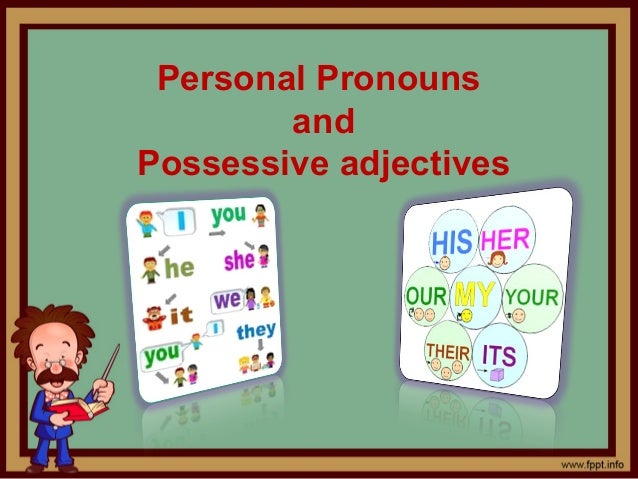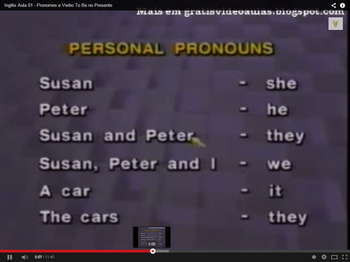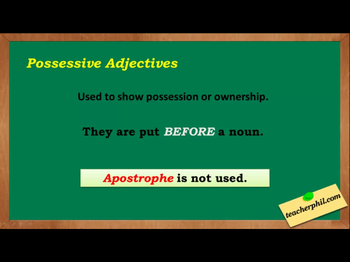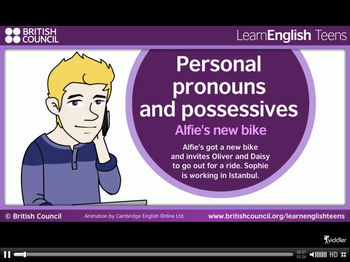24/11/2014
Eliana Dias e Lazuíta Goretti de Oliveira
| Modalidade / Nível de Ensino | Componente Curricular | Tema |
|---|---|---|
| Ensino Médio | Língua Estrangeira | Compreensão oral |
| Ensino Fundamental Final | Língua Estrangeira | Textos orais com marcas entonacionais e pronúncia |
| Ensino Médio | Língua Estrangeira | Compreensão leitora |
| Ensino Fundamental Final | Língua Estrangeira | Aspectos morfológicos, sintáticos e fonológicos |
| Ensino Fundamental Final | Língua Estrangeira | Grau de formalidade na escrita e na fala |
| Ensino Médio | Língua Estrangeira | Produção oral |
| Ensino Médio | Língua Estrangeira | Competência comunicativa: componentes linguísticos, sociolinguísticos e pragmáticos |
| Ensino Fundamental Final | Língua Estrangeira | Organização textual |
| Ensino Médio | Língua Estrangeira | Produção escrita |
O que o aluno poderá aprender com esta aula
reconhecer e saber utilizar os pronomes pessoais e possessivos
Duração das atividades
Conhecimentos prévios trabalhados pelo professor com o aluno
não há necessidade
Estratégias e recursos da aula
recursos multimídia;
imagens veiculadas na internet;
atividades xerocopiadas;
atividades online;
trabalhos individuais e em grupos;
vídeos
PERSONAL PRONOUNS AND POSSESSIVE ADJECTIVES

MÓDULO 1
Atividade 1
Introduza a aula apresentando o seguinte texto, com explicações iniciais sobre o tema da aula. Solicite a leitura dos alunos, revezando as suas participações. Corrija os problemas com pronúncia e ajude-os com o vocabulário desconhecido. Peça para que a cada explicação, os alunos criem seus próprios exemplos e escreva-os no quadro.
We use personal pronouns (I, me, he, him, etc.) to replace names or nouns when it is clear what they refer to. We use possessives (my, your, her) when it is not necessary to name the person the thing belongs to.
We use personal pronouns to avoid repeating nouns.
Mum's calling. She’s in Turkey.
How’s Daisy? Give her my love.
You used she because it’s the subject and her because it’s the object.
Very good. Here’s the list of all the personal pronouns and possessive adjectives:
| Subject pronoun | Object pronoun | Possessive adjective | Possessive pronoun |
| I | me | my | mine |
| you | you | your | yours |
| he | him | his | his |
| she | her | hers | hers |
| it | it | its | - |
| we | us | our | ours |
| they | them | their | theirs |
We use pronouns to avoid repetition when it is obvious what we are talking about.
Is this your bike? > No, that one’s mine. (= my bike)
Those red gloves are yours; the blue ones are hers. (= her gloves)
Can I use two pronouns together?
Yes, for example:
The man in the shop gave me them free.
So, what do I need to be careful about?
Well, sometimes we use me when it might seem logical to use I. We also use it sometimes to refer to people.
I love house music > I do too / Me too.
Who’s that? > Me. / It’s me. / It’s Fran.
Sometimes we use they instead of he or she, them instead of him or her and their instead of his or hers.
When you meet your new teacher, they will give you the books.
If anyone asks where I am, tell them I’m in Istanbul this week.
Someone left their gloves in the classroom.
What about animals?
We usually use it/they for animals, but when people are talking about their own pets, they use he or she.
The dog must be thirsty. Give him some water.
Yes, one thinks that animals are just like people, doesn’t one?
Ah, we don’t use one to mean everyone very much. It sounds very old-fashioned and too formal. We use you to mean people in general.
You can see the sea from the top of that mountain. (you = people in general)
But the Queen uses one?
That's true. But, I haven’t met the Queen and you should use you!
Fonte adaptada: http://learnenglishteens.britishcouncil.org/grammar-vocabulary/grammar-videos/personal-pronouns-and-possessives (acesso em 15.11.2014)
Atividade 2
A fim de complementar as explicações anteriores, reproduza o vídeo disponível em http://www.youtube.com/watch?v=Plhp6jhjBQs. Em um primeiro momento, os alunos deverão apenas prestar atenção na explicação dos pronomes pessoais. Em um segundo momento, pause o vídeo a cada momento que julgar pertinente reforçar o conteúdo apresentado no vídeo.

Imagem ilustrativa do primeiro vídeo sugerido
Atividade 3
Continue a explicação do conteúdo, apresentando o vídeo disponível em http://www.youtube.com/watch?v=8g-Z8rRfiG4 (acesso em 16.11.2014). Conduza a atividade da mesma forma da anterior, pausando o vídeo nos momentos em que a explicação deverá ser reforçada.

Imagem ilustrativa do referido vídeo
MÓDULO 2
LET´S PRACTICE

Imagem fonte: https://www.google.com.br/search?q=LET%C2%B4S+PRACTICE&espv=2&biw=1024&bih=600&source=lnms&tbm=isch&sa=X&ei=SJto
52Fusedbooksinclass.com%252F2012%252F08%252F%3B276%3B183 (acesso em 16.11.2014)
Atividade 4
Depois de assistirem aos dois vídeos, distribua o seguinte quadro e peça para que os alunos o complete com os personal pronouns and possessive adjectives. Peça para que escrevam a correção no quadro, facilitando a visualização.
Complete the table with personal pronouns and possessive adjectives.
| Personal Pronouns |
Possessive Adjectives |
Personal Pronouns |
Possessive Adjectives |
| Singular |
Plural |
||
| I |
my |
we |
our |
|
|
|
|
|
|
|
|
|
|
|
|
|
|
|
|
|
|
|
|
Atividade 5
Distribua uma cópia dos exercícios a seguir para cada aluno. Em pares, eles deverão fazer os dois exercícios, que se referem a completar os espaços com os pronomes pessoais e possessivos adequados. Disponibilize um tempo de, aproximadamente, 10 minutos, segundo a necessidade do grupo. Para a correção, os alunos deverão ir ao quadro e escrever suas respostas. Possibilite, sempre, a criação de um ambiente interativo e participativo do grupo.
A. Fill in the blank using the correct personal pronoun (subject): I, you, he, she, it, we, you, and they.
1. Hello! How are ________? ________? am fine, thanks.
2. Peter and I aren’t in the same class but ________? ________’re good friends.
3. Mrs Graf isn’t my mother. ________’s my teacher.
4. Mr Park is Portuguese. ________ lives in Lisbon.
5. Tim and Mark aren’t singers. ________ are football players.
6. That computer isn’t modern. ________ is an old one.
7. You and John look so young! ________ are handsome.
B. Fill in the blanks using the possessive adjectives: my, your, his, her, its, our, your, their.
1. Brian is a boy and __________ surname is Forbes.
2. The cat is a pet. __________ ears are black with white spots.
3. I’m a designer and __________ favourite TV channel is “Fashion”.
4. It is raining and you haven’t got __________ umbrella with you.
5. Nanny and you are twins. __________parents are Mr and Mrs Brown.
6. Take these colouring pencils. I like __________ colour.
Adaptado de: http://busyteacher.org/11494-personal-pronouns-possessive-adjectives-verb-to.html (acesso em 16.11.2014)
Atividade 6
Distribua uma cópia da atividade a seguir, em que os alunos deverão trocar as expressões sublinhadas pelos pronomes adequados. A tarefa deverá ser realizada individualmente. Circule pela sala, observando e tirando possíveis dúvidas. A correção deverá ser oral e com a participação de todos os alunos.
A- Replace the underlined expressions by the adequate pronoun. Follow the example.
1. The boyis in the classroom.
He is in it.
2. Kateis a journalist.
_____________________________________________
3. John and Lucyare married.
_____________________________________________
4. Mark has got a book for Carol.
_____________________________________________________________________
5. Here is the box. Open the box, please.
_____________________________________________________________________
6. Are Pierre and Susanne English?
_____________________________________________________________________
7. Here is a letter for Nancy and her sister. Take the letter with you.
_____________________________________________________________________
8. Martinis helping his mother.
_____________________________________________________________________
9. Betty and Iare playing in the stadium.
_____________________________________________________________________
10. The knifeis on the table.
_____________________________________________________________________
11. Harry and Aliceare looking at my mother and me.
_____________________________________________________________________
12. Can you and John help with the children?
_____________________________________________________________________
13. The booksare on the table.
_____________________________________________________________________
14. You and Ihave got a nice watch for Ted.
_____________________________________________________________________
15. My grandparentsalways write with ball-pens.
_____________________________________________________________________
16. He phones his girl-friend every evening.
_____________________________________________________________________
17. The telephone is ringing. Answer the telephone.
_____________________________________________________________________
18. My friends and Iare tellingGeorge about our holiday.
_____________________________________________________________________
Answer key
2. She
3. They
4. He / Her
5. it
6. they
7. them / it
8. he / her
9. We / it
10. It / it
11. they / us
12. you / them
13. They / it
14. We / him
15. they / them
16. her
17. it
18. We / him / it
Atividade 7
Para finalizar a aula, reproduza o seguinte vídeo, disponível em: http://learnenglishteens.britishcouncil.org/grammar-vocabulary/grammar-videos/personal-pronouns-and-possessives (acesso em 15.11.2014) e peça para que em um primeiro momento os alunos respondam às seguintes perguntas, relacionadas à história apresentada:
1) What does Alfie invite Oliver and Daisy to do?
2) Why doesn´t Daisy go?
3) When was Alfie´s birthday?
4) Where is Sophie?
5) What is she doing there?
6) Describe some of the touristic places she has visited there.
Em seguida, os alunos deverão identificar oralmente todos os personal pronouns and possessives que aparecem no vídeo. Na etapa seguinte, distribua o transcript para cada aluno e peça para que sublinhem todos os personal pronouns and possessives, identificando a que eles se referem no texto.

Imagem ilustrativa do referido vídeo
Transcript:
Oliver: Hey, Alfie. How's things?
Alfie: Cool, great. You? What are you up to?
Oliver: Me? Nothing much. I'm just sitting here with a coffee and the laptop.
Alfie: Ah. Are you doing that project Doc. Taylor gave us? An analysis of motivation in ...
Oliver: No, I'm reading the newspaper on it. Politics ... the world economy ...
Alfie: Oh right, the football results.
Oliver: Exactly. “International relations”, but on a football pitch! Anyway, what can I do for you?
Alfie: Well, I've got a new bike! My uncle bought it for me – it's my birthday present.
Oliver: Wow! Did you tell him he's more than six months late?
Alfie: No, I'm not complaining – a present's a present, and it's a nice bike. He got me a helmet too, and I've got some cool cycling gloves as well – the man in the shop gave me them free. So, why don't you come round with yours and we can take them for a ride?
Oliver: The gloves?
Alfie: Ha ha. The bikes ... take the bikes for a ride. See if Daisy wants to bring hers too.
Oliver: Daisy's out with that new friend of hers, Amy. Hang on. Mum's calling. She's in Turkey. Let me talk to her and I'll call you back.
Alfie: OK. Say 'Hi' to her from me.
Oliver: Will do. Hi, Mum.
Sophie: Honey! Hi!
Oliver: How's Istanbul?
Sophie: I'm loving it.
Oliver: But you love everywhere you go ...
Sophie: True! But seriously, it's great fun – you'd love it ... all the different 'meze' at lunch, oh the colours, and they bring you lots and you choose which ones you want – look, here's a photo.
Oliver: Oh, wow!
Sophie: And I've been to the Blue Mosque, the Hagia Sofía – of course, with my name! Um, the Topkapi Palace... That's what you can see behind me. Oh, and I'm going on a night cruise on the Bosphorus tonight. It's really an amazing city, modern but traditional, full of culture and colour and …
Oliver: So take me there. Or take us. Daisy'd like it too, wouldn't she?
Sophie: She would, yes, I'm sure.
Oliver: And have you been to a Turkish Bath yet?
Sophie: Yes, a hammam. I went to one yesterday, I loved it! Now, the taxis here – they drive a bit differently from ours back in Britain. They’re a bit scary! Anyway, love, I've got to go. How's Daisy? Give her my love!
Oliver: OK, Mum. Bye. Hi, it's me again. So tell me about this bike of yours, is it anything like mine?
Recursos Complementares
Para outras atividades online, acesse:
http://learnenglishteens.britishcouncil.org/grammar-vocabulary/grammar-videos/personal-pronouns-and-possessives (acesso em 15.11.2014);
http://learnenglishteens.britishcouncil.org/grammar-vocabulary/grammar-videos/personal-pronouns-and-possessives (acesso em 15.11.2014);
http://learnenglishteens.britishcouncil.org/grammar-vocabulary/grammar-videos/personal-pronouns-and-possessives (acesso em 15.11.2014)
Para outros vídeos, acesse:
http://www.youtube.com/watch?v=W-gOgoxFbgI (acesso em 16.11.2014)
Avaliação
Todas as atividades deverão ser avaliadas pelos professor, que deverá observar a interação e o envolvimento de cada aluno durante a aula.
Para uma avaliação formal, os alunos poderão procurar um pequeno texto na internet ou mesmo criá-lo e identificar todos os pronomes pessoais e possessivos, mencionando a que eles se referem. Corrija a atividade individualmente com a participação de cada aluno, para que identifiquem seus próprios e possíveis erros.
Cinco estrelas 2 classificações
- Cinco estrelas 2/2 - 100%
- Quatro estrelas 0/2 - 0%
- Três estrelas 0/2 - 0%
- Duas estrelas 0/2 - 0%
- Uma estrela 0/2 - 0%
Denuncie opiniões ou materiais indevidos!
Opiniões
-
Rita de Cacia Venancio Vieira, E.E.Secretário Tristão da Cunha , Minas Gerais - disse:
ritadecaciavenanciovieira@yahoo.com.br01/07/2015
Cinco estrelasParabéns professora! Excelente aula.
-
GUILHERME PAULO AQUINO GONCALVES, ESCOLA PEQUENO POLEGAR , Ceará - disse:
aquinoguilherme2014@bol.com.br05/02/2015
Cinco estrelasMuito bem professora!!! Adorei!!!
- Sugestão de aula
- Aulas
- Coleções de aulas
- Criar aula
- Criar individual
- Criar em equipe
- Gerenciar equipes
- Minhas aulas
- Orientações
- Criando equipes
- Dicas para a produção de aulas
- Reflexões pedagógicas
- Utilizando a ferramenta
- Artigo: portal educacional
- Estatísticas de uso do Portal
- Estatísticas de aulas
- Estatísticas de recursos
- Estatísticas de visitas
- Recursos utilizados em aulas
- Reflexões pedagógicas
- Informações de cursos
- Cursos
- e-Proinfo
- Materiais de cursos
- Materiais de estudo
- Artigos e publicações
- Assuntos relevantes
- Avaliações
- Ciência do cotidiano
- Destaques internacionais
- Dicas práticas
- Educação profissional e tecnológica
- Entrevistas
- Estratégias pedagógicas
- Inovações tecnológicas
- Materiais de cursos
- Materiais de evento
- Orientações e diretrizes
- Parâmetros e referencias
- Programas em vídeos
- Tutoriais
- TVescola
- Ferramentas do portal
- Fórum
- Portal do Youtube
- Compartilhando apresentação
- Ferramentas pela internet
- Blog
- Compartilhe vídeos
- Comunicação on-line
- Crie e compartilhe apresentações
- Edite e compartilhe fotos
- Escrita colaborativa
- Junte-se a uma comunicade
- Lista de discussão
- Organize e compartilhe favoritos
- Podcast
- Rádio/TVs Universitárias e outros
- Redes Sociais
- Robô Ed
PLATAFORMA FREIRE
- Bibliotecas
- Capacitação Proinfo Integrado
- Cultura
- Dicionários, tradutores e enciclopédias
- Educação inclusiva
- Geoprocessamentos
- Inclusão digital
- Infográficos
- Jogos educativos
- Jornais
- Museus
- Observatórios e planetários
- Organizações governamentais
- Plataformas educacionais
- Portais educacionais e outros
- Portal MEC
- Prêmio professores do Brasil
- Produções de professores
- Projetos de escolas
- Projetos inovadores
- Projetos sociais e educacionais
- Rádio escola
- Recursos digitais
- Revistas
- Sites de busca
- Sites temáticos do portal e TVescola
- Softwares de edição e outros
- Softwares educacionais
- Um computador por aluno

- Ryan Oksenhorn
- Ryan Snow
- Sergio Caldara
- Shane Miler
- Shane Herzog
- Sotirios Papavasilopoulos
- Stephen JB Thomas
- Tarah
- Valera Nazarov
- ZbigniewMa K Flakus


